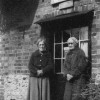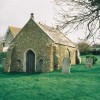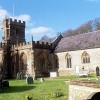The village of Thorncombe is situated close to the border with Somerset and Devon in an area of outstandingly beautiful countryside. The Cottages lining its hilly streets appear to have more in common with Devon than Dorset, which is not surprising as until 1843 the parish, a part of the Axminster hundred, was in Devon. The village is recorded in Domesday as Tomecone and was held by Viscount Baldwin de Brionne. The name derives from the Saxon torn and cumb meaning low ground where thorns grow.
The church is new, built in 1867 on a site about 50 yards north from the old church, largely from the rubble of its predecessor that was demolished eighteen months earlier. The old church, in common with many other ancient churches, had over the centuries been so patched up as to make it unrecognisable from the original design and character of the church first dedicated by Bishop Brewster of Exeter in 1239. At the time of its demolition the old church consisted of a west tower, home to a chiming clock and five bells; a nave; north and south aisles; a chancel and two galleries.
Commenting on the demolition of the old church, a local newspaper report of 1867 says; “The Old Church at Thorncombe was a great antiquity and possessed many features of interest in connection with the ancient faith. It must have been endeared to the parishioners by a thousand sacred associations and we can hardly suppose that its entire destruction can really be the source of unmixed pleasure. The reasons assigned for the destruction of the church are that it has been allowed to fall into so dilapidated a state as to be beyond repair, and that, without the hideous galleries, which it was wisely determined to remove, sufficient accommodation could not be obtained.”
St. Mary’s had served the parish well, although as early as the late 18th century there were rumblings of discontent about its condition and inability to accommodate all the parishioners (apparently a quarter of them could not get in). The new church was designed by J. Mountford Allen of Crewkerne. Included in the new building is a fifteenth century brass representing Sir Thomas and Lady Joan Brook of which Pevsner says: “The best brasses in Dorset.” The present church houses five bells and has a restored 16th century pulpit with linen-fold panelling. The vicar’s pew includes early 17th century panels and figures. Just outside of the village there were two dissenting chapels: the Venn Chapel and the Ebenezer Chapel; we believe both are now private residences.
John Bragge, a member of the Sadborrow family, was rector here and a royalist sympathiser. He was fined so heavily by Cromwell that he was unable to perform his duties towards his parishioners. On his death the post was left vacant and the villagers had to petition Parliament; as a result the Reverend Samuel Hood was the rector here from 1761 to 1777. His two sons Samuel and Alexander both rose to become Admirals.
Thirty-three men from Thorncombe were sought after by the notorious Judge Jeffries for their part in the failed Monmouth Rebellion during the 17th century, though few of them were captured.
The ruins of a fortified manor house, the home of the Brook family, can be found in the hamlet of Holditch; another hamlet within the parish is Hewood. The hamlet of Laymore is the site of a former flax works. In the 18th century Thorncombe was involved in the wool trade and lace-making industry. As these industries moved away the population that had stood at about 1,500 declined; the 2001 census produced a population figure of 714 for the parish.
Also within the parish is Sadborow, a country house of neo-classical design set in a small park, built between 1773 and 1775 by John Johnson. By far the most interesting and important building here is Forde Abbey, which will be the subject of a separate article.



